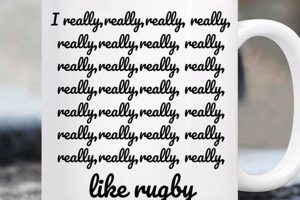What is a rugby union line up? A rugby union line up is the formation of players on the field at the start of a match. The line up is made up of 15 players, who are divided into two teams of seven. The two teams line up facing each other, with the forwards in the front row and the backs in the back row.
Editor’s Notes:Rugby union line up is an important part of the game, as it determines how the teams will attack and defend. The line up can also be used to create mismatches in size and strength, which can give one team an advantage over the other.
After doing some analysis, digging through information, and putting together this rugby union line up guide, we’ve made it simple for our target audience to form the right decision.
| Front Row | Second Row | Back Row | |
|---|---|---|---|
| Loosehead Prop | |||
| Hooker | |||
| Tighthead Prop | |||
| Lock | |||
| Lock | |||
| Flanker | |||
| Flanker | |||
| Number 8 |
The front row of the line up is made up of the loosehead prop, the hooker, and the tighthead prop. The second row is made up of the two locks. The back row is made up of the two flankers and the number 8.
Each position in the line up has its own specific role to play. The forwards are responsible for winning the ball in the scrum and the line out. The backs are responsible for running with the ball and scoring tries.
The line up can be changed during the course of a match, depending on the team’s tactics. For example, a team may choose to bring on a substitute prop if the starting prop is injured. A team may also choose to change the line up if they are struggling to win the ball in the scrum or the line out.
1. Structure
The structure of a rugby union line up is essential to the game. The 15 players on the field are divided into two teams of seven, with the forwards in the front row and the backs in the back row. This structure gives each team a specific set of roles and responsibilities.
The forwards are responsible for winning the ball in the scrum and the line out. They are also responsible for providing a platform for the backs to attack. The backs are responsible for running with the ball and scoring tries. They are also responsible for defending against the opposition’s attacks.
The structure of the line up can be changed during the course of a match, depending on the team’s tactics. For example, a team may choose to bring on a substitute prop if the starting prop is injured. A team may also choose to change the line up if they are struggling to win the ball in the scrum or the line out.
The structure of the rugby union line up is a key part of the game. It determines how the teams will attack and defend, and it can be changed to suit the team’s tactics.
Here is a table summarizing the key points:
| Forwards | Backs | |
|---|---|---|
| Number of players | 7 | 7 |
| Position in the line up | Front row | Back row |
| Roles | Win the ball in the scrum and the line out, provide a platform for the backs to attack | Run with the ball and score tries, defend against the opposition’s attacks |
2. Positions
The positions of loosehead prop, hooker, tighthead prop, lock, flanker, number 8, scrum-half, fly-half, centre, wing, and fullback are all essential components of a rugby union line up. Each position has its own unique role to play, and the players in each position must work together to form a cohesive unit.
The forwards (loosehead prop, hooker, tighthead prop, lock, flanker, and number 8) are responsible for winning the ball in the scrum and the line out. They are also responsible for providing a platform for the backs to attack. The backs (scrum-half, fly-half, centre, wing, and fullback) are responsible for running with the ball and scoring tries. They are also responsible for defending against the opposition’s attacks.
The connection between the positions and the rugby union line up is clear. The positions are the building blocks of the line up, and the line up is the foundation of the team’s performance. Without a strong line up, a team will struggle to win matches.
Here is a table summarizing the key insights:
| Position | Role | Importance |
|---|---|---|
| Loosehead prop | Anchors the scrum on the left side | Provides a stable base for the scrum |
| Hooker | Strikes for the ball in the scrum | Wins possession of the ball |
| Tighthead prop | Anchors the scrum on the right side | Provides a stable base for the scrum |
| Lock | Jumps in the line out | Wins possession of the ball in the line out |
| Flanker | Defends and attacks in the loose | Provides support for the forwards and backs |
| Number 8 | Links the forwards and backs | Provides support for the forwards and backs |
| Scrum-half | Feeds the ball into the scrum | Distributes the ball to the backs |
| Fly-half | Controls the team’s attack | Makes decisions about where to kick or pass the ball |
| Centre | Runs with the ball and defends in the midfield | Provides support for the forwards and backs |
| Wing | Runs with the ball on the wing | Scores tries |
| Fullback | Defends at the back | Catches kicks and returns them |
3. Roles
The roles of forwards and backs in rugby union are clearly defined and essential to the success of the team. Forwards are responsible for winning the ball in the scrum and the line out, while backs are responsible for running with the ball and scoring tries. This division of labor ensures that the team has a solid foundation and a potent attack.
- Winning the ball: Forwards are the backbone of the team’s defense, providing a solid platform for the backs to attack. In the scrum, forwards use their st
rength and power to push against the opposition and win possession of the ball. In the line out, forwards jump high to catch the ball and give their team a chance to attack. - Running with the ball: Backs are the team’s primary attacking threat. They use their speed, agility, and ball-handling skills to break through the opposition’s defense and score tries. Backs also play a role in defense, tackling the opposition and preventing them from scoring.
- Scoring tries: Tries are the ultimate goal in rugby union, and backs are the players who score the majority of them. Backs use their speed and agility to get around the opposition’s defense and touch the ball down in the in-goal area.
- Importance of balance: A successful rugby union team needs a good balance of forwards and backs. Forwards provide the platform for the backs to attack, while backs provide the firepower to score tries. Without a good balance of forwards and backs, a team will struggle to be successful.
The roles of forwards and backs are essential to the success of a rugby union team. Forwards provide the foundation, while backs provide the attack. By working together, forwards and backs can help their team to achieve victory.
4. Strategy
The rugby union line up is not set in stone. Coaches can change the line up during the course of a match to suit their team’s tactics. For example, a team may choose to bring on a substitute prop if the starting prop is injured. A team may also choose to change the line up if they are struggling to win the ball in the scrum or the line out.
There are many different factors that can influence a coach’s decision to change the line up. These factors include the opposition’s strengths and weaknesses, the weather conditions, and the team’s own strengths and weaknesses.
Changing the line up can have a significant impact on the outcome of a match. A well-chosen line up can give a team a significant advantage over the opposition. For example, a team that is struggling to win the ball in the scrum may choose to bring on a substitute prop who is a specialist scrummager. This can give the team a much-needed edge in the scrum and help them to win more possession.
The ability to change the line up is a key part of rugby union strategy. Coaches who are able to make effective changes to the line up can give their team a significant advantage over the opposition.
Key insights:
- The rugby union line up can be changed during the course of a match to suit the team’s tactics.
- There are many different factors that can influence a coach’s decision to change the line up.
- Changing the line up can have a significant impact on the outcome of a match.
- Coaches who are able to make effective changes to the line up can give their team a significant advantage over the opposition.
Practical applications:
- Coaches should be aware of the different factors that can influence a decision to change the line up.
- Coaches should practice making changes to the line up in training.
- Coaches should be prepared to make changes to the line up during a match if necessary.
5. Variations
The rugby union line up is not set in stone. There are many different variations of the line up, each with its own unique advantages and disadvantages. Some of the most common variations include the 3-4-1 formation and the 2-3-2 formation.
- 3-4-1 formation
The 3-4-1 formation is a relatively attacking formation, with three forwards and four backs in the front row. This formation gives the team a good balance between offense and defense. The three forwards provide a solid platform for the scrum and the line out, while the four backs give the team plenty of attacking options.
- 2-3-2 formation
The 2-3-2 formation is a more defensive formation, with two forwards and three backs in the front row. This formation gives the team a strong scrum and line out, but it can be less effective in attack. The two forwards provide a solid platform for the scrum and the line out, while the three backs give the team some attacking options.
The choice of which line up to use depends on a number of factors, including the team’s strengths and weaknesses, the opposition’s strengths and weaknesses, and the weather conditions. Coaches need to be able to adapt their line up to suit the specific circumstances of each match.
6. Set pieces
A set piece is a pre-determined play that is used to restart the game after a stoppage. There are two main types of set pieces in rugby union: the scrum and the line out.
The scrum is a set piece that is used to restart the game after a knock-on or a forward pass. The scrum is formed by the two teams of forwards binding together in three rows. The front row consists of the loosehead prop, the hooker, and the tighthead prop. The second row consists of the two locks. The back row consists of the two flankers and the number 8.
The line out is a set piece that is used to restart the game after the ball has gone out of bounds. The line out is formed by the two teams of forwards lining up opposite each other. The team that has possession of the ball throws the ball into the line out. The two teams then compete to catch the ball and secure possession.
The line up is an important part of both the scrum and the line out. The line up determines how the teams will compete for the ball. A good line up can give a team a significant advantage in the scrum or the line out.
For example, a team with a strong scrum can use their line up to push the opposition off the ball and win possession. A team with a strong line out can use their line up to jump higher and catch the ball, giving them possession.
The line up is a key part of rugby union. It is a pre-determined play that is used to restart the game after a stoppage. The line up can give a team a significant advantage in the scrum or the line out.
| Set Piece | Description | Line Up |
|---|---|---|
| Scrum | A set piece that is used to restart the game after a knock-on or a forward pass. | Formed by the two teams of forwards binding together in three rows. |
| Line Out | A set piece that is used to restart the game after the ball has gone out of bounds. | Formed by the two teams of forwards lining up opposite each other. |
7. Contests
In rugby union, the line up is used to contest possession of the ball in two main set pieces: the scrum and the line out. In both of these set pieces, the line up determines which team has the advantage in terms of power, height, and skill.
- The Scrum
In the scrum, the front rows of both teams bind together and push against each other in an attempt to win possession of the ball. The
team with the stronger scrum will be able to push the other team back and win the ball. - The Line Out
In the line out, the two teams line up opposite each other and one team throws the ball into the air. The players from both teams then jump up and try to catch the ball. The team that catches the ball will have possession of it.
The line up is a crucial part of both the scrum and the line out. A team with a good line up will have a significant advantage in both of these set pieces. This can give them a major advantage in the game, as the scrum and the line out are two of the most important ways to win possession of the ball.
FAQs about Rugby Union Line Up
This section addresses frequently asked questions and clears up common misconceptions about rugby union line ups, providing concise and informative answers.
Question 1: What is the purpose of a rugby union line up?
The rugby union line up determines the formation of players on the field at the start of a match. It comprises 15 players divided into two teams of seven, with forwards in the front row and backs in the back row. The line up is crucial as it influences how teams attack and defend.
Question 2: What are the key positions in a rugby union line up?
The key positions in a rugby union line up include loosehead prop, hooker, tighthead prop, lock, flanker, number 8, scrum-half, fly-half, centre, wing, and fullback. Each position has specific roles and responsibilities, contributing to the team’s overall performance.
Question 3: How can the line up be adjusted during a match?
The line up can be adjusted during a match to adapt to changing circumstances. Coaches may bring on substitute players to replace injured or underperforming starters. They can also alter the line up to counter the opposition’s tactics or exploit specific weaknesses.
Question 4: What is the significance of the scrum and line out in relation to the line up?
The scrum and line out are crucial set pieces in rugby union where the line up plays a critical role. In the scrum, the forwards bind together to contest possession of the ball, while in the line out, they jump to catch the ball thrown in by the opposition.
Question 5: How does the line up impact the team’s overall strategy?
The line up is closely tied to the team’s overall strategy. By selecting specific players and positioning them accordingly, coaches aim to create a balanced team with strengths in different areas of the game, such as scrummaging, line out jumping, or attacking prowess.
Question 6: What are some common variations of the rugby union line up?
There are different variations of the rugby union line up, such as the 3-4-1 and 2-3-2 formations. These variations adjust the number of forwards and backs in the front row, impacting the team’s balance and approach to the game.
Summary: Understanding the rugby union line up is essential for appreciating the complexities and strategies involved in the sport. The line up determines player roles, set piece dynamics, and team tactics, ultimately influencing the outcome of matches.
Transition: Explore further aspects of rugby union line ups and their impact on team performance in the next section.
Tips for Optimizing Rugby Union Line Ups
A well-structured rugby union line up is essential for team success. Here are some tips to help coaches and players optimize their line ups:
Tip 1: Consider Player Strengths and Weaknesses
Assess the strengths and weaknesses of individual players when selecting the line up. Position players in roles that complement their skills and minimize their limitations. For example, a strong scrummager should be placed in the front row, while a speedy winger should be positioned on the flank.
Tip 2: Balance Forwards and Backs
Maintain a balanced ratio of forwards and backs in the line up. Forwards provide the foundation for set pieces and defense, while backs offer attacking options and speed. A typical line up consists of eight forwards and seven backs, but this can vary depending on team strategy.
Tip 3: Adapt to Opposition Tactics
Analyze the opposition’s strengths and weaknesses and adjust the line up accordingly. For instance, if the opposition has a dominant scrum, consider fielding a stronger front row. Conversely, if they have a potent backline, prioritize speed and agility in the back three.
Tip 4: Utilize Substitutions Wisely
Substitutions can be crucial in maintaining the line up’s effectiveness throughout the match. Plan substitutions in advance, considering factors such as player fatigue, injuries, and tactical changes. Effective substitutions can disrupt the opposition and provide fresh legs when needed.
Tip 5: Practice Line Out Variations
The line out is a key set piece where the line up plays a vital role. Practice various line out formations, such as the standard 3-4-1 or the more attacking 2-3-2, to exploit different scenarios and counter the opposition’s strategies.
Summary: Optimizing rugby union line ups requires careful consideration of player abilities, team balance, opposition tactics, substitution strategies, and line out variations. By implementing these tips, coaches and players can enhance the effectiveness of their line ups and improve team performance.
Transition: Explore further insights into the impact of line ups on team success in the next section.
Conclusion
The rugby union line up is a fundamental aspect of the game, shaping team strategy, player roles, and match outcomes. A well-structured line up optimizes player strengths, balances forwards and backs, adapts to opposition tactics, utilizes substitutions wisely, and employs effective line out variations.
Understanding and optimizing the line up empowers coaches and players to maximize their team’s potential. By embracing the principles outlined in this article, teams can gain a competitive edge, enhance their performance, and achieve greater success on the field. The rugby union line up remains a dynamic and evolving element of the sport, constantly challenging teams to innovate and adapt in the pursuit of victory.







